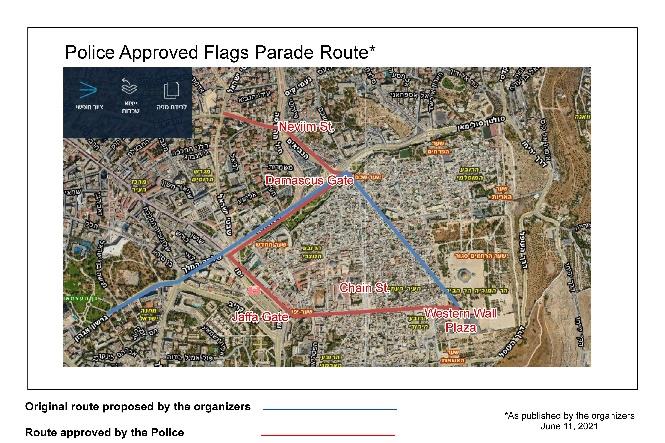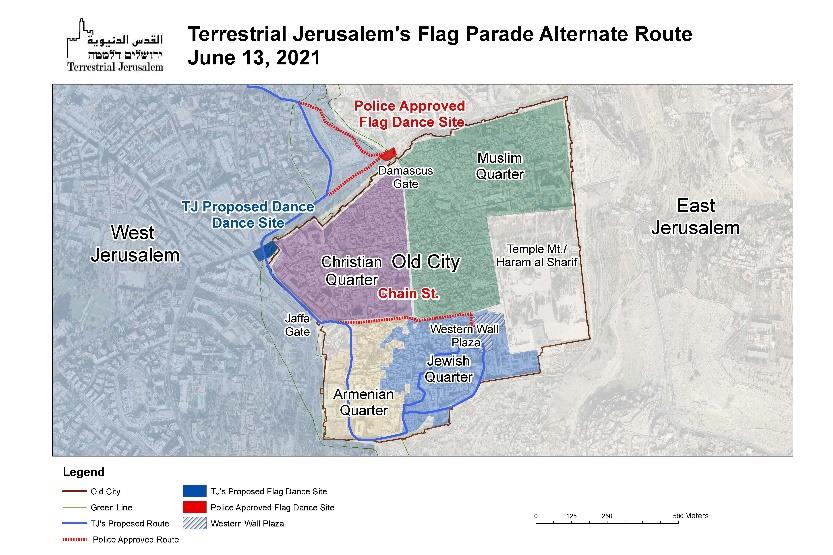Summary:
- The Flags Parade is scheduled for Tuesday, June 15 at 4 PM (the day after tomorrow).
- The underlying causes that sparked the last round of violence – Sheikh Jarrah, the status quo on Haram al Sharif and deep despair – remain, and clashes continue almost daily.
- Should the parade proceed, the outbreak of clashes is highly likely, and the prospect of bloodier and more widespread violence a distinct possibility.
- Another (intended) victim of this eventuality might be the just formed coalition government.
- Every effort should be made to prevent this outcome:
- A deferral will allow the matter to be considered under more auspicious circumstances.
- Assigning the decision to the Security Cabinet enables all intelligence community and security arms to weigh in.
- Altering the route [see map and details below] might reduce friction and prospects of violence.
The urgent situation created by the planned Flags Parade requires immediate attention. This overshadows other important developments in Jerusalem that will have to be addressed very soon – i.e. the risk of evictions in Sheikh Jarrah and the situation in and around Haram al Sharif/Temple Mount – and which we will cover in our next edition.
This report can be downloaded here.
Background
Over the years, the Flags Parade has become one of the central events of the extreme, national religious right. Traditionally taking place on Jerusalem Day, tens of thousand march along a route that includes the Muslim Quarter of the Old City. Racist chants are common, and violence always a possibility. The Supreme Court has ruled in recent years that, with great reluctance, the parade could take place.
The potential for violence during this year’s parade was at an unprecedented high. There had already been weeks of clashes between Palestinian youth and the Police regarding Ramadan restrictions at Damascus Gate (on the route of the march) and in Sheikh Jarrah. Under pressure from political echelons, the Police agreed to allow the march, originally scheduled for Jerusalem day, May 10, to proceed in its customary route through the Muslim Quarter. However, as the march began, Netanyahu instructed the Police to reroute it away from the Damascus Gate, and move the route to the less problematic Jaffa Gate.
The anger of the organizers became moot within an hour, when the first salvo of Hamas rockets was launched towards Jerusalem. The parade was never completed.
Undeterred, the parade organizers rescheduled it for June 10, insisting that the march go through the Damascus Gate and the Muslim Quarter of the Old City. A new argument was added to their arsenal: it was cowardly allowing Hamas to prevent Jews from exercising their sovereignty in their eternal capital. When the Police balked, indicating the route need be negotiated based on security concerns, Netanyahu and members of his cabinet – in the waning days of their term in office – indicated their support of the marchers.
A bitter dispute erupted between the Prime Minister and Defense Minister Gantz, who opposed the parade on grounds of national security and public safety. A compromise was cobbled out, whereby the parade would take place on Tuesday June 15 – less than 48 hours after the swearing in of the new Government – under conditions “to be determined”. Little doubt was left in the public mind that Netanyahu supports the march, even through the Muslim Quarter, while Gantz has grave reservations.
The Agreement between the Police and the Organizers
According to parade organizers, on Friday June 11, they reached an agreement with the Jerusalem Police regarding the route. While this may appear as an attempt by the Police to pre-empt the new Government, it is clear that the decision will be revaluated once they take office. That said, the new Government is coming into office confronting not only a highly problematic event, just hours away, but also a highly problematic, albeit tentative agreement on the route.
This map released by the organizers designates the route they had proposed in blue, and the agreed route, approved by the Police in red. There is a number of important differences. The original route was to proceed from West Jerusalem through Damascus Gate and the Muslim Quarter, ending at the Western Wall. The new route begins in West Jerusalem proceeding along Neviim St. But rather than entering the Muslim Quarter through Damascus Gate, there will be a Flag Dance that will take place at Damascus Gate itself.

From there, the march will proceed counter-clockwise towards Jaffa Gate, outside and alongside the ramparts of the Old City. Upon entering Jaffa Gate, the parade will proceed to the east on Street of the Chain St., the major thoroughfare leading from Jaffa Gate to the Gate of the Chain on Haram al Sharif/the Temple Mount. While the street traverses all four quarters of the Old City, all of the shop owners on the street are Palestinian, overwhelmingly, if not exclusively, Muslim. The march will enter the Western Wall Plaza from the Street of the Chain.
.Will the new route defuse the situation?
We believe that even with this new route, violent clashes with the Palestinians remain likely, with a wider and bloodier conflict remaining quite possible. Hamas has already called for a “day of rage”, asking Palestinians to demonstrate at the gate of Al Aqsa Mosque to block the parade.
Firstly, as “inconvenient” as this may be politically, any parade in or around the Old City at this point in time might spark violence. Jerusalem is a tinderbox. The underlying causes that sparked the last round of violence – Sheikh Jarrah, the status quo on Haram al Sharif and deep despair – remain, and clashes continue almost daily.
And we need to take a harder look at the recent clashes between the Police and Palestinian youth. This is a report posted by Nir Hasson of Haaretz on June 10:
“From a number of discussions today, it turns out that a lot of folks don’t know: almost 100% of the demonstrations violently dispersed by the Police in E. Jérusalem were non-violent. In almost all cases the dispersal began when Palestinian flags were flown [not illegal -D.S.] or nationalistic slogans shouted. The Police don’t even deny it. Violently dispersed means: rubber bullets, the skunk, horse mounted Police, gas, billyclubs. A relatively new addition to these means – the use of billyclubs. Of late a new and popular trend. Including right now at Damascus Gate”.
Palestinian youth believe, not without reason, that the Police view them as the enemy, and they, in return view the Police as the ultimate symbol of occupation. The inevitable comparison of how the settlers and the extreme right are being treated by the Police alone can spark violence.
Secondly, if one aspires create another round of violence in Jerusalem, few events offer better prospect of success than having a flag-waving nationalistic event that Damascus Gate. While Damascus Gate is of no special significance in the Jewish tradition, it is a symbol second only to al Aqsa to the Palestinians of East Jerusalem. And it was the persuasive sense that Damascus Gate, like Haram al Sharif, was slipping away from the Palestinian people, when the Police prevented young Palestinians from gathering there during Ramadan, that ignited the city several weeks ago.
The choice of conducting a Flag Dance at Damascus Gate virtually guarantees an outbreak of violence.
Finally, the newly approved route also proceeds through Palestinian parts of the Old City, albeit in a location perceived as less hostile. The shop owners will shutter their stores well in advance with metal shutters. If they fail to do so, the Police will compel them to. But that won’t likely be necessary. They know that if they remain open during the march, their stores will be trashed and they will be in physical danger. And that’s “the acceptable” route”.
What happens next?
The new Bennett Government has been sworn yesterday, on June 13. The Parade is scheduled at 4 PM on June 15.
The New Minister of Internal Security, Omer Bar-Lev, was interviewed in the media. He said that all he knows about the issue is from the media, but that his tendency will be to back the Chief of Police. That said, he will, in his first hours in office, convene the Police Command for an operational evaluation. Should he have doubts or reservations, he continued, he will bring the decision before the Security Cabinet.
Bar Lev is a political moderate with a wealth of operational and command experience. He will not likely take this decision alone, among else because it would not be wise for him to volunteer to take sole responsibility for an impossibly challenging decision.
The matter will likely be brought urgently before the Security Cabinet. For the record, its members are: the PM, Lapid, Gantz, Lieberman, Michaeli, Saar, Horowitz, Shaked, and Bar-Lev.
Those sympathetic to cancelling, deferring or radically limiting the march are more or less equal in number to those who will support the marchers.
What can be done?
If the Bennett Government allows the Parade to proceed, and there is indeed an outbreak of violence, it will put an enormous strain on a government only hours old. If the Parade is deferred or its route altered, Netanyahu will orchestrate, openly or with a disingenuous roll of the eyes, a groundswell of rage, real and feigned, from the right. In either case, violence of some sort – Israeli, Palestinian, or both – is a distinct possibility. In either case, the newly formed Bennett-Lapid Coalition may well be torn asunder. This malevolent “stress test” has been Netanyahu’s goal all along.
Netanyahu tossed a grenade with its pin removed into the hands of the newly-formed government. He did it with malice aforethought in the hopes of fomenting the Israeli version of January 6.
Every effort should be made to elicit a deferral of the parade so that the matter may be considered under more auspicious circumstances. One of the benefits of deliberations before the Security Cabinet is that all of Israel’s intelligence community and security arms will weigh in. Much depends on what they will say.
However, should it be decided to allow the parade to proceed, there are three changes, tactical in nature, that might reduce, but not eliminate, the chances of an outbreak of violence.
This map displays our proposed changes and indicates how they compare with the route as currently approved by the Police. Firstly, reroute the parade so that it can be described as going by Damascus Gate, without coming into close proximity with the Gate itself. It won’t suffice for the marchers, but it will have some impact on public opinion. It will also mean that there will be no Flag Dance at Damascus Gate.

Move the site of the Flag Dance 500 meters to the southwest, to the northwest corner of the Old City. It will be closer to the ramparts of the Old City than the Damascus Gate location, and far less incendiary.
Finally, once inside Jaffa Gate, the march should proceed not through the Street of the Chain, but through the Armenian Quarter. The Armenian Quarter is no less the Old City than the Muslim Quarter. The route that passes through it is no less convenient, but will significantly reduce the levels of tension possibility of an eruption of violence.
